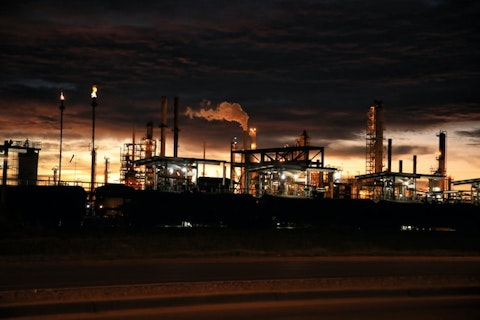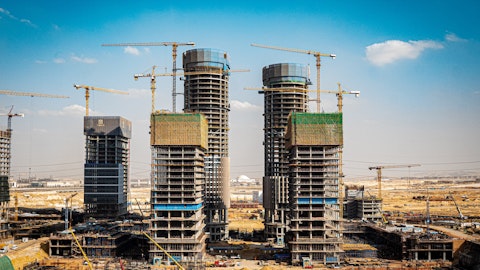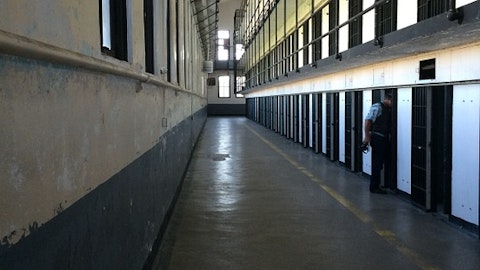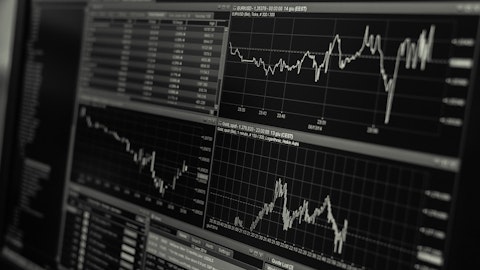Olin Corporation (NYSE:OLN) Q4 2022 Earnings Call Transcript January 27, 2023
Operator: Good morning, and welcome to the Olin Corporation’s Fourth Quarter 2022 Earnings Conference Call. Please note this is being recorded. I would now like to turn the conference over to Steve Keenan, Olin’s Director of Investor Relations. Please go ahead, Steve.
Steve Keenan: Thank you, Anthony. Good morning, everyone, and thank you for joining us again today. Before we begin, let me remind you that this discussion, along with the associated slides and the question-and-answer session that follows, will include statements regarding estimates or expectations of future performance. Please note that these are forward-looking statements and that actual results could differ materially from those projected. Some of the factors that could cause actual results to differ from our projections are described without limitations in the Risk Factors section of our most recent Form 10-K and in yesterday’s fourth quarter earnings press release. A copy of today’s transcript and slides will be available on our website in the Investors section under Past Events.
Our earnings press release and other financial data and information are available under press releases. With me this morning are Scott Sutton, Olin CEO; Damian Gumpel, President, Epoxy; Patrick Schumacher, President, Chlor Alkali; Brett Flaugher, President, Winchester; and Todd Slater, Olin CFO. The leadership team will make some brief remarks, after which we’ll be happy to take your questions. I’ll now turn the call over to Scott Sutton.
Scott Sutton: Yes. Thanks, Steve, and good morning to everyone. In 2022, Olin generated $12 per share of levered free cash flow, repurchased more than 25 million shares and reduced our net debt by $200 million. It was a massive team effort after generating $9 per share of levered free cash flow in 2021. As we head into 2023, our markets are not healthy, yet our focus on levered free cash flow remains the same and we expect to generate approximately $7 per share of levered free cash flow in this recession year. From an EBITDA perspective, we worked in the $2.4 billion to the $2.5 billion range the last 2 years and we expect to generate at least 2/3 of that average in the trough that is 2023. For Olin, the key features of early 2023 include continuing to idle our complete global epoxy resin business due to suspended demand in the largest consuming regions of China and Europe, rectifying a transient fat supply channel in commercial ammunition via lower Olin participation rate, kicking off the operation of the blue water…
Operator: Please hold as we try to connect with the main speaker line. Thank you.

Photo by Robin Sommer on Unsplash
A – Scott Sutton: I understand that we dropped. I won’t repeat the first part of my comments, but I’ll start where I think we dropped off. So for Olin, the key features of early 2023 include continuing to idle our complete global epoxy resin business due to suspended demand in the largest consuming regions of China and Europe, rectifying a transient fat supply channel in commercial ammunition via lower Olin participation rate, kicking off the operation of the Bluewater alliance with Mitsui to manage much more the world’s liquidity in chlor alkali and recognizing another solid pricing lift in our merchant chlorine business. While some of these features of the first quarter of 2023 are already impactful in a slightly negative way, it is still possible that we may have to take more drastic action in a subsequent quarter to recoil further and preserve product values for the rebound toward the latter part of the year.
In 2023, expect us to hold our current net debt position, keep buying shares throughout the year, gain an investment-grade rating, complete our asset footprint adjustment decisions and prepare for a quality growth story in 2024. We’ve also updated our 2022 ESG scorecard progress on Page 10 of the presentation. This is a growing theme for Olin, and we look forward to showing the results from our focus in this area. Now Damian, Patrick and Brett will each make a few brief comments on both the situation and our initiatives across all 3 businesses and then Todd will follow with additional commentary on our 2022 accomplishments and 2023 outlook.
Damian Gumpel: Thank you, Scott, and good morning. On Slide 4, Epoxy Q4 results are partly a reflection of seasonal demand, but principally our disciplined approach to water the most challenging landscape in 14 years which led us to deeply pull back resin production that would have otherwise harmed the landscape. While anticipating improvement in the back half of ’23, we focus today on productivity, optimizing our asset base, enhancing our sustainability profile and positioning for value-based growth. On this last point, we supercharged the business during Q4 of 2022. Putting our differentiated systems product portfolio under seasoned leadership in new product commercialization. I look forward to sharing on future calls the role Olin epoxy plays in addressing global energy, mobility and infrastructure challenges in a sustainable way and how that translates into shareholder value growth. I’ll now turn it over to Patrick Schumacher for chlor alkali.
Patrick Schumacher: Thanks, Damian. Even though 2022 was an all-time record year, the second half of 2022 brought significant challenges which we are likely to continue into the first half of 2023. Pricing in the vinyls chain remains weak and continues to necessitate lower Olin operating rates. On the positive side, our merchant chlorine ratchet continues to turn only one way. Chlorine pricing is expected to step up through 2023 as legacy contracts end. Bleach has been another success story and we expect both products to show substantial earnings growth again in 2023. Our Blue Water Alliance is now one of the world’s largest traders of EDC and caustic and will be an important part of the Olin value creation for years to come. I’ll now turn it over to Brett for an update on Winchester.
Brett Flaugher: Thanks, Patrick. The Winchester team continued to maximize value throughout 2022. However, during the second half of the year, we started to experience a transition in our commercial ammunition business from refilling depleted inventories to filling inventories to the rate of our customer sales. And in some cases, especially small caliber rifle, inventories became high. So we decided to manufacture and sell less to preserve value for both Olin and our customers. With nearly 15 million new participants entering the recreational shooting sports over the past few years, we believe demand for our leading Winchester ammunition products will remain stronger than historical levels. We continue to see opportunities within our military segment with demand increases from current and new international military customers as well as increased government funding to modernize the Army Lake City facility.
As we manage through this commercial ammunition transition, our focus will be on growing and preserving value for the #1 brand in the ammunition industry. I will turn it over to you, Todd.
Todd Slater: Thanks, Brett. Throughout the last 2 years, Olin has generated $3.1 billion of levered free cash flow. Our capital allocation was initially focused on the balance sheet, whereby we reduced outstanding debt by $1.3 billion over the 2-year period. With our investment-grade balance sheet set, we primarily deployed our remaining levered free cash flow towards share repurchases totaling $1.6 billion over the last 2 years. In fact, during 2022, we reduced our outstanding shares by approximately 16%, all from cash flow. In 2023, despite the challenging global economic conditions, we’re forecasting to generate recessionary trough level levered free cash flow of approximately $1 billion which equates to about a 13% free cash flow yield.
Our 2023 cash flow includes a couple of unusual items. Our cash tax rate is expected to be higher than normal due to deferred international tax payments of approximately $80 million that are forecast to be paid this year. Also, we are expecting a peak payment level under our long-term energy supply contracts of approximately $75 million. Finally, our investment-grade balance sheet and cash flow should enable Olin to continue to deploy a substantial portion of our 2023 levered free cash flow towards share repurchases. That concludes our prepared remarks. And Anthony, we are now ready to take questions.
See also 13 Cheap New Stocks To Buy and 11 Tech Stocks with Low PE Ratio.
Q&A Session
Follow Olin Corp (NYSE:OLN)
Follow Olin Corp (NYSE:OLN)
Operator: Our first question will come from Hassan Ahmed with Alembic Global.
Hassan Ahmed : Got a question around the 2023 guidance you guys gave, obviously sort of in line with sort of the trough range that you guys have been talking about, the $1.5 billion to $2 billion. So look, I mean I take a look at the Q4 adjusted EBITDA, $442 million. I annualized that, and I get to $1.77 billion, which is squarely sort of the midpoint of the trough and 2023 guidance that you guys have given. And you guys obviously achieved this sort of the Q4 EBITDA in the face of extreme adversity, right? I mean a massive destock, most of your end markets being as weak as they were, the epoxy business doing what it was doing. And on top of that, obviously, Q4 being a seasonally weak quarter. I guess the only tailwind you guys have had in the quarter and it seems on a go-forward basis is chlor alkali pricing, right?
So as I sort of sit there and talk to investors, some of the cynics may turn around and say, hey, look, one of the things that has been dropping up EBITDA and — is chlor alkali pricing, and it just can’t go on rising forever. So it may crack. Again, I’m not in that camp, but what could you tell us to sort of give us a little more confidence that even with the macro looking the way it’s looking, you’re not really going to see any cracks in chlor alkali price.
Scott Sutton : Yes. Thanks, Hassan. I mean that’s a good summary. I mean, I would also urge you to think about what’s the cause and effect here, right? I mean Olin is absolutely the leader here and is setting the value equation. It’s no doubt that pricing in chlor alkali, especially in some of the derivatives can go up from here and they can go down from here as well. But we have some very solid footing there. And I’ll ask Patrick to add a little color on Olin’s footing.
Patrick Schumacher : Sure. Yes, Hassan. Thanks for the question. It’s definitely possible, as Scott said, that you could see lower prices, maybe caustic goes down from records but other — we’re going to run to the weak side. We’ve baked in or locked in a lift in chlorine prices for this year over last year of at least $100 million, and vinyls prices have been very, very weak for at least half of the year. So there’s been a recent uptick in prices there. So maybe those prices start to tick up. So we expect a mixture this coming year of maybe some higher prices and maybe some lower prices.
Hassan Ahmed : Fair enough. Fair enough. And as a follow-up, just sort of trying to get a lay of the land with regards to inventory. I mean you guys, obviously, on the chlorovinyl side pointed towards certain end markets being sort of particularly weak, be it TiO2, be it the urethane side, be it the vinyl side. I mean as I’m sort of sitting there and looking at, call it, certain TiO2 producers, they’re talking about volume declines as high as 30%, right? So I’m just trying to get a sense of if you could sort of give us a sense of where inventories are for you guys, for the industry? And if at all, there is a restock, how sort of impressive could that snapback in demand.
Patrick Schumacher : Yes. Sure. 30%, I’ll take your word for that. If you look at our chlorine business year-over-year, volumes are definitely down. But netbacks are definitely way up. Chlorine and the chlorine side of the ECU has been the weak side of the ECU because we’ve been talking to you guys for the last — well, this would be the third quarter. So we’re running to that weaker side, and we’re managing rates for that weaker chlorine side of the ECU and that is lifting netbacks, which is offsetting those lower volumes.





